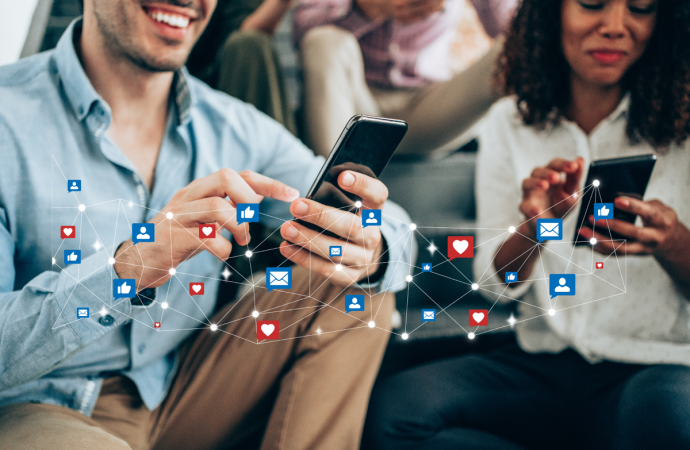Introduction In today’s digital world, social media plays a huge role in how we connect with others, learn new things, and share our lives. Just a couple of decades ago, communication was slower and more limited. Letters, landline calls, and emails were the norm. But the arrival of platforms like Facebook, Twitter, and Instagram changed
Introduction
In today’s digital world, social media plays a huge role in how we connect with others, learn new things, and share our lives. Just a couple of decades ago, communication was slower and more limited. Letters, landline calls, and emails were the norm. But the arrival of platforms like Facebook, Twitter, and Instagram changed everything. These platforms didn’t just make it easier to stay in touch—they transformed how people across the globe talk, share news, and build communities. This article explores how these three platforms changed global communication in powerful and lasting ways.
The Rise of Social Media
When Facebook launched in 2004, it started as a site just for college students. But soon, it grew into a global network where people could connect with friends and family, share updates, and discover new content. Twitter followed in 2006 with a different approach—short, real-time updates that focused on fast information sharing. Then in 2010, Instagram joined the scene, introducing a new way to connect through photos and videos. Together, these three platforms helped shape the modern digital age.
Facebook: Connecting Friends and Communities
Facebook made it easy for people to reconnect with old friends, share life events, and create online communities. It offered features like:
- Timelines to post updates and photos
- Messenger for private chats
- Groups and pages for shared interests
- News feeds that deliver content based on preferences
This platform helped people feel closer, even if they lived far apart. Families could share pictures, friends could chat instantly, and people could join groups about anything—from parenting tips to sports fan clubs.
Facebook also became a key space for local businesses, nonprofits, and schools to stay connected with their audiences. It turned into more than a social site—it became a communication hub for people of all ages.
Twitter: Real-Time News and Global Conversations
Twitter introduced a new way to communicate using short messages called tweets. With a 280-character limit, users had to be quick and clear. This made Twitter perfect for:
- Breaking news
- Live event updates
- Public conversations
- Sharing thoughts and opinions instantly
The hashtag (#) system allowed users to find and follow topics easily. From global events to personal stories, people could see what was trending and join conversations from anywhere in the world.
Twitter also gave a voice to everyday users and helped movements like #BlackLivesMatter and #MeToo gain momentum. It created space for public dialogue, activism, and awareness that traditional media often couldn’t match in speed or reach.
Instagram: Sharing Stories Through Images
Instagram shifted the focus to visual content. People could post pictures, add filters, and express themselves through creativity. Over time, Instagram added features like:
- Stories (short-term photo and video updates)
- IGTV for longer videos
- Reels for quick, entertaining clips
- Shopping options for businesses
This platform became especially popular with younger users and influencers. It created a culture around aesthetics, lifestyle sharing, and digital storytelling. Brands also embraced Instagram, using it to showcase products and connect with customers in a visually engaging way.
Table: Feature Comparison of Facebook, Twitter, and Instagram
| Platform | Launched | Key Feature | Focus Area |
|---|---|---|---|
| 2004 | Timeline, Messenger, Groups | Community and networking | |
| 2006 | Tweets, Hashtags | News and live conversation | |
| 2010 | Photos, Stories, Reels | Visual storytelling |
Global Reach and Cultural Impact
These platforms connected people across different cultures, languages, and time zones. They made the world feel smaller and more accessible. Through social media:
- Travelers could share real-time adventures
- Artists could showcase their work to a global audience
- Students could find resources and make study groups
- People could learn about other cultures instantly
News also traveled faster than ever. During major global events, people turned to social media to see what was happening. Photos, videos, and first-hand updates replaced long news reports. This made people more informed but also brought challenges with false information.
Changing Business Communication
Businesses of all sizes began to use social media to reach customers directly. Facebook allowed targeted advertising. Twitter gave companies a place to answer customer questions in real time. Instagram let brands create a visual identity.
These tools helped brands become more personal. They could build relationships, tell their stories, and respond to feedback. It also gave small businesses a chance to grow without needing a big budget.
Social Movements and Digital Activism
One of the most powerful effects of social media was the way it helped social and political movements spread. On Twitter, hashtags helped people organize protests and campaigns. On Facebook, groups provided space to gather support. On Instagram, images and videos told powerful stories.
These platforms allowed people who once felt unheard to speak out. Whether raising money, fighting injustice, or spreading awareness, social media helped amplify voices that may have otherwise gone unnoticed.
The Role of Algorithms
Each platform uses algorithms to decide what users see. These algorithms look at what you like, who you follow, and what you interact with. While this can make content more relevant, it also creates echo chambers—where people mostly see ideas they already agree with.
This has sparked debate about how these platforms shape opinions and influence behavior. Efforts are being made to improve transparency and give users more control over what they see.
Challenges and Concerns
With all the positive changes, social media has also brought new problems:
- Privacy concerns about how data is collected and used
- Misinformation spreading quickly before being verified
- Mental health issues from comparing lives or facing online bullying
- Addiction to screen time and constant notifications
It’s important to use these platforms wisely and be mindful of how they affect our daily lives and well-being.
Future of Social Media Communication
As technology improves, social media will continue to evolve. Virtual reality (VR), augmented reality (AR), and artificial intelligence (AI) are expected to make digital communication even more interactive. Future platforms may feel more like real conversations than screen interactions.
Meanwhile, users are demanding safer, more respectful spaces online. This will push companies to create better tools for moderation, content control, and community support.
Conclusion
Facebook, Twitter, and Instagram have completely changed how the world communicates. They turned simple conversations into global experiences and made it easier to share stories, ideas, and emotions. From friends staying in touch to movements changing society, these platforms play a major role in modern life.
While they come with challenges, they also offer endless possibilities for connection and creativity. As these platforms grow and change, one thing remains clear—social media will continue to shape how we connect, communicate, and understand the world around us.























Leave a Comment
Your email address will not be published. Required fields are marked with *